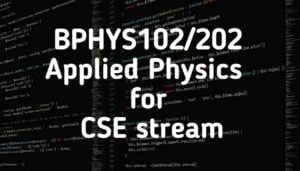
BPHYS102/202 Applied Physics for CSE stream
Syllabus Copy
Module - 1
Laser and Optical Fibers
LASER
Characteristic properties of a LASER beam, Interaction of Radiation with Matter, Einstein’s A and B Coefficients and Expression for Energy Density (Derivation), Laser Action, Population Inversion, Metastable State, Requisites of a laser system, Semiconductor Diode Laser, Applications: Bar code scanner, Laser Printer, Laser Cooling(Qualitative), Numerical Problems.
Optical Fiber:
Principle and Structure, Propagation of Light, Acceptance angle and Numerical Aperture (NA), Derivation of Expression for NA, Modes of Propagation, RI Profile, Classification of Optical Fibers, Attenuation and Fiber Losses, Applications: Fiber Optic networking, Fiber Optic Communication. Numerical Problems
Module - 2
Quantum Mechanics:
de Broglie Hypothesis and Matter Waves, de Broglie wavelength and derivation of expression by analogy, Phase Velocity and Group Velocity, Heisenberg’s Uncertainty Principle and its application (Non existence of electron inside the nucleus – Non Relativistic), Principle of Complementarity, Wave Function, Time independent Schrödinger wave equation (Derivation), Physical Significance of a wave function and Born Interpretation, Expectation value, Eigen functions and Eigen Values, Particle inside one dimensional infinite potential well, Quantization of Energy States, Waveforms and Probabilities. Numerical Problems
Module - 3
Quantum Computing: Principles of Quantum Information & Quantum
Computing:
Introduction to Quantum Computing, Moore’s law & its end, Differences between Classical & Quantum computing. Concept of qubit and its properties. Representation of qubit by Bloch sphere. Single and Two qubits. Extension to N qubits.
Dirac representation and matrix operations:
Matrix representation of 0 and 1 States, Identity Operator I, Applying I to|0⟩and |1⟩ states, Pauli Matrices and its operations on |0⟩and |1⟩states, Explanation of i) Conjugate of a matrix and ii) Transpose of a matrix. Unitary matrix U, Examples: Row and Column Matrices and their multiplication (Inner Product), Probability, and Quantum Superposition, normalization rule. Orthogonality, Orthonormality. Numerical Problems
Quantum Gates: Single Qubit Gates:
Quantum Not Gate, Pauli – X, Y and Z Gates, Hadamard Gate, Phase Gate (or S Gate), T Gate
Multiple Qubit Gates:
Controlled gate, CNOT Gate, (Discussion for 4 different input states). Representation of Swap gate, Controlled -Z gate, Toffoli gate.
Module - 4
Electrical Properties of Materials and Applications
Electrical Conductivity in metals
Resistivity and Mobility, Concept of Phonon, Matheissen’s rule, Failures of Classical Free Electron Theory, Assumptions of Quantum Free Electron Theory, Fermi Energy, Density of States, Fermi Factor, Variation of Fermi Factor With Temperature and Energy. Numerical Problems.
Superconductivity
Introduction to Super Conductors, Temperature dependence of resistivity, Meissner’s Effect, Critical Field, Temperature dependence of Critical field, Types of Super Conductors, BCS theory (Qualitative), Quantum Tunnelling, High Temperature superconductivity, Josephson Junctions (Qualitative), DC and RF SQUIDs (Qualitative), Applications in Quantum Computing: Charge, Phase and Flux qubits, Numerical Problems.
Module - 5
Applications of Physics in computing:
Physics of Animation:
Taxonomy of physics based animation methods, Frames, Frames per Second, Size and Scale, Weight and Strength, Motion and Timing in Animations, Constant Force and Acceleration, The Odd rule, Odd-rule Scenarios, Motion Graphs, Examples of Character Animation: Jumping, Parts of Jump, Jump Magnification, Stop Time, Walking: Strides and Steps, Walk Timing. Numerical Problems
Statistical Physics for Computing:
Descriptive statistics and inferential statistics, Poisson distribution and modeling the probability of proton decay, Normal Distributions (Bell Curves), Monte Carlo Method: Determination of Value of π. Numerical Problems.